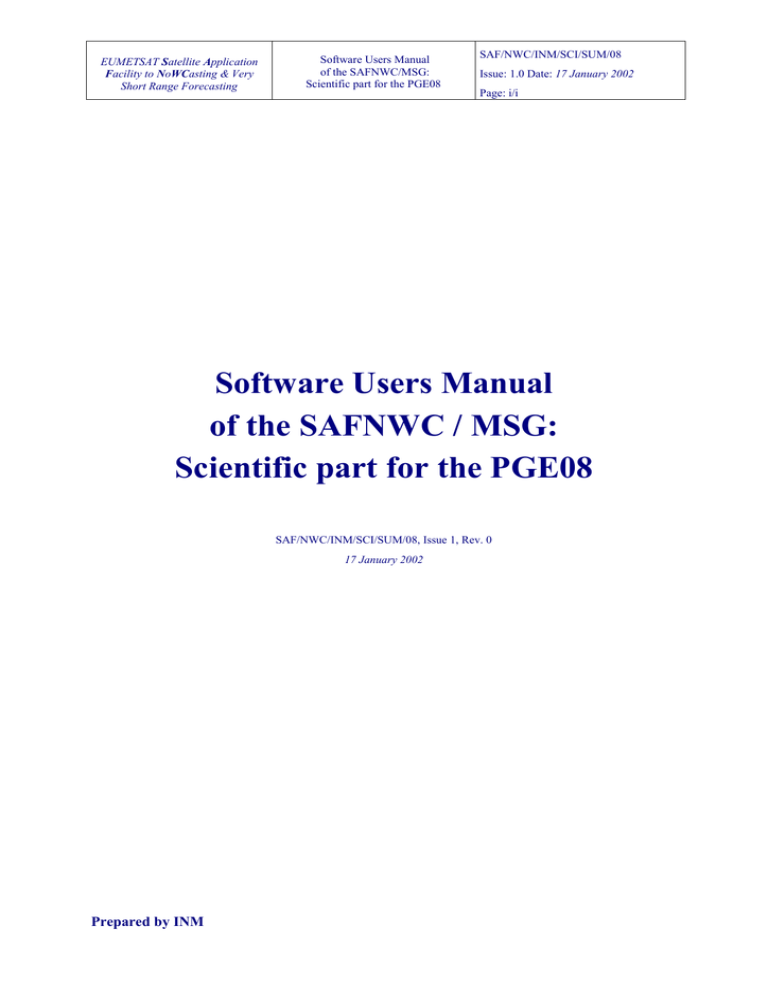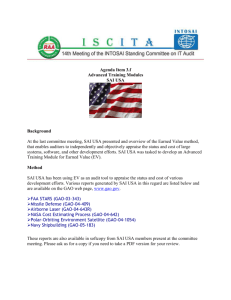S F SAF/NWC/INM/SCI/SUM/08 Software Users Manual
advertisement

EUMETSAT Satellite Application Facility to NoWCasting & Very Short Range Forecasting Software Users Manual of the SAFNWC/MSG: Scientific part for the PGE08 SAF/NWC/INM/SCI/SUM/08 Issue: 1.0 Date: 17 January 2002 Page: i/i Software Users Manual of the SAFNWC / MSG: Scientific part for the PGE08 SAF/NWC/INM/SCI/SUM/08, Issue 1, Rev. 0 17 January 2002 Prepared by INM EUMETSAT Satellite Application Facility to NoWCasting & Very Short Range Forecasting Software Users Manual of the SAFNWC/MSG: Scientific part for the PGE08 SAF/NWC/INM/SCI/SUM/08 Issue: 1.0 Date: 17 January 2002 Page: i/iii REPORT SIGNATURE TABLE Function Prepared by Reviewed by Name Signature Date M. Velazquez (INM) 17 January 2002 M.A. Martinez (INM) M. Manso (INM) 17 January 2002 L.F. Lopez-Cotin Authorised by SAFNWC/MSG Project Manager 17 January 2002 Software Users Manual of the SAFNWC/MSG: Scientific part for the PGE08 EUMETSAT Satellite Application Facility to NoWCasting & Very Short Range Forecasting SAF/NWC/INM/SCI/SUM/08 Issue: 1.0 Date: 17 January 2002 Page: ii/iii DOCUMENT CHANGE RECORD Version 1.0 Date 17 January 2002 Pages 13 CHANGE(S) First published version SAF/NWC/INM/SCI/SUM/08 : EUMETSAT Satellite Application Facility to NoWCasting & Very Short Range Forecasting Software Users Manual of the SAFNWC/MSG: Scientific part for the PGE08 SAF/NWC/INM/SCI/SUM/08 Issue: 1.0 Date: 17 January 2002 Page: iii/iii Table of contents 1. 1.1 1.2 1.3 2. INTRODUCTION ...................................................................................................................1 SCOPE OF THE DOCUMENT .......................................................................................................1 SCOPE OF OTHER DOCUMENTS.................................................................................................1 SOFTWARE VERSION IDENTIFICATION .....................................................................................1 DESCRIPTION OF SAI PRODUCT ....................................................................................2 2.1 GOAL OF SAI PRODUCT ...........................................................................................................2 2.2 SAI ALGORITHM DETAILED DESCRIPTION ...............................................................................2 2.2.1. Algorithm outline...........................................................................................................2 Spatial smoothing of SEVIRI radiances ........................................................................................3 Normalitation. ...............................................................................................................................4 Satellite zenith angle correction....................................................................................................4 SAI Neural Network.......................................................................................................................4 Quality control ..............................................................................................................................5 De-normalitation. ..........................................................................................................................5 LI Spatial Smoothing .....................................................................................................................6 2.3 LIST OF INPUT FOR SAI ............................................................................................................6 2.4 DESCRIPTION OF SAI OUTPUT .................................................................................................6 Description of the conversion from Celsius degrees to brightness values ....................................6 Description of SAI output format ..................................................................................................7 2.5 EXAMPLE OF SAI VISUALISATION ...........................................................................................8 2.6 IMPLEMENTATION OF SAI.......................................................................................................9 2.6.1 The SAI installation step: ............................................................................................10 2.6.2 The SAI preparation step: ...........................................................................................10 2.6.3 The SAI execution step: ...............................................................................................10 ANNEX 1: ANCILLARY DATA.................................................................................................10 ANNEX 2. REFERENCES ...........................................................................................................12 ANNEX 3. ACRONYMS ..............................................................................................................13 EUMETSAT Satellite Application Facility to NoWCasting & Very Short Range Forecasting Software Users Manual of the SAFNWC/MSG: Scientific part for the PGE08 SAF/NWC/INM/SCI/SUM/08 Issue: 1.0 Date: 17 January 2002 Page: 1/13 1. INTRODUCTION 1.1 SCOPE OF THE DOCUMENT This document contains a scientific description of the algorithms used for PGE08 implementation, including the expected input data, the output product and the method adopted for a better understanding of the software. Due to the lack of real SEVIRI data availability, a most detailed optimal estimation and realistic testing of the resulting models constitute the baseline to the Initial Operations Phase (IOP). 1.2 SCOPE OF OTHER DOCUMENTS The software part of the Software User Manual (SUM) describes the individual processes, which make up the system with a description of the software and operational environment associated Details of input and output data format of this product are described in the Interface Control Documents ICD1 (for the External and Internal Interfaces of the SAFNWC/MSG) and ICD3 (MSG Output Product Format Definition). The general architecture of the software is described in the Architectural Design Document (ADD) (interface with the SAFNWC software, architecture of the PGE). The document is denoted as SAF/NWC/INM/SW/AD/4, 1.01. The product generator elements are described in the Software Version Description (SVD). The document is denoted as SAF/NWC/INM/SW/SVD/3, 1.01. The evolution of the scientific developments have been presented in the SAFNWC Scientific Report from MTR on PGE08 Stability Analysis Imagery, together with two verbal presentations in the EUMETSAT Meteorological Satellite Data User's Conferences (Martınez et al, 1999 and Martınez & Velazquez, 2001). 1.3 SOFTWARE VERSION IDENTIFICATION This document describes the algorithms implemented in the release v.1.0.1 of SAFNWC/MSG for PGE08 EUMETSAT Satellite Application Facility to NoWCasting & Very Short Range Forecasting Software Users Manual of the SAFNWC/MSG: Scientific part for the PGE08 SAF/NWC/INM/SCI/SUM/08 Issue: 1.0 Date: 17 January 2002 Page: 2/ 13 2. DESCRIPTION OF SAI PRODUCT 2.1 GOAL OF SAI PRODUCT The software to extract Stability Analysis Imagery (SAI) from MSG SEVIRI Imagery over MSG N has been designed within the EUMETSAT SAF for support to Nowcasting and Very Short Range Forecasting (hereafter referred as SAFNWC). The Stability Analysis Imagery (SAI), developed within the SAF NWC context, aims to support nowcasting applications. The SAI allows obtain one measure of the stability in cloud free areas. The central aim of the SAI is therefore to provide estimations of the atmospheric instability in cloud-free areas. Among all potential indexes the Lifted Index (LI) has been implemented and codified. The product output provides quantitative information on the LI. A conversion from Celsius degrees to grey levels or digital count is necessary for writing LI output in only 7 bits. The SAI is designed to derive estimations of the Lifted Index using seven MSG IR multispectral radiances (6.2, 7.3, 8.7, 9.7, 12.0 & 13.4µm). The PGE01 (Clod Mask-CMa) product identifies the first cloud free for which the SAI is later obtained. SAI's main algorithm has been devised as a neural network with a resulting topology. It is possible that during the tuning phase, other topology with different number of neurones in the hidden layer could present better performances when the real data will be available. Therefore, the software has been designed to change the topology and weights only changing the name of the new neural networks in the configuration file. When the PGE08 is started, all the names of the files with the neural networks are read from the configuration file and the topology and weights are allocated and loaded. The software has been structured in order to introduce easily other stability indexes. Other stability index can be obtained, just by changing the sea and land neural network files, the Look Up Table (LUT) using in the denormalization process and the thresholds used in the conversion to grey levels or counts. 2.2 SAI ALGORITHM DETAILED DESCRIPTION 2.2.1. Algorithm outline The implementation and validation of SAI algorithms are based mainly on synthetic cases and sensitivity studies, as real satellite data availability (NOAA and GOES) did not present any channels comparable to MSG's 8.7µm during the development phase. The detailed description of these developments has been shown in different scientific documents: Scientific Report from MTR on PGE08 Stability Analysis Imagery, together with two verbal presentations in the EUMETSAT Meteorological Satellite Data User's Conferences (Martınez et al, 1999 and Martınez & Velazquez, 2001). The CMa output is used to identify clear air pixels. Only if the pixel is labelled as air clear and the satellite zenith angle of this pixel lies within the configurable threshold the pre-processing and processing is calculated in this pixel. The whole process includes: 1. Pre-processing: EUMETSAT Satellite Application Facility to NoWCasting & Very Short Range Forecasting Software Users Manual of the SAFNWC/MSG: Scientific part for the PGE08 SAF/NWC/INM/SCI/SUM/08 Issue: 1.0 Date: 17 January 2002 Page: 3/ 13 • Smoothing of SEVIRI radiances (optional) performing a median o mean/average (configurable in the model configuration file) over a window centred at the processing pixel. Boundaries of the region are not considered. • Normalisation of SEVIRI radiances. • Correction of SEVIRI radiances to 45¼MSG zenith angle. This step will use a dedicated neural network, whose inputs are the SEVIRI radiances and the satellite zenith angle. 2. Processing: The calculus of the lifted index will use dedicated Neural Networks (NN). The NNs will be fed with normalized corrected IR SEVIRI radiance values (WV6.2, WV6.3, IR8.7, IR9.7, IR10.8, IR12.0 & IR13.4µm), and will provide as output the normalized lifted index. For land pixels the normalised altitude is also needed as input for the neural network. 3. Quality control: To check the product quality, different flags have been added to the output products. • Clear air flag: Derived from the cloud mask product PGE01 CMa. • Out of radiance flag: Indicates how many bands are out of range for product confidence purposes. • Number of cloudy pixels in the processing window: indicating the confidence of the smooth pre-processing step. 4. Post-processing: The post-processing step will include: • Denormalisation of the lifted index to Celsius degrees. A LUT is used in this step. • Smoothing of the LI when it is required in the model configuration file, given the proper parameters such as method to use (mean/average or median), length of the processing box and minimum number of cloud free pixels in the window to perform the smoothing. The process consists of making a mean/average or a median of the parameter over a window centred at the pixel. • Conversion of LI form Celsius degrees to grey levels using coefficients specified in the model configuration file. • Over cloudy pixel, a configurable IR channel is shown. Spatial smoothing of SEVIRI radiances The seven IR spectral bands observed by the MSG used as input in this SAF product, will be smoothed regardless of the configuration files having or not a line with the prefixed spatial smoothing. For each channel it is possible to introduce an independent line in the configuration file. This line specifies the width of the window to use in the smoothing and the applied method. Two different smoothing methods have been codified: the first one is the average and the second one the median (See ADD). Only the pixels in the predefined window labelled as clear air and with satellite zenith angles within the configurable threshold will be taken in account during the smoothing process. The number of the cloudy pixels in the biggest window will be used as a quality control flag. EUMETSAT Satellite Application Facility to NoWCasting & Very Short Range Forecasting Software Users Manual of the SAFNWC/MSG: Scientific part for the PGE08 SAF/NWC/INM/SCI/SUM/08 Issue: 1.0 Date: 17 January 2002 Page: 4/ 13 Normalitation. The NN used for obtaining corrected satellite zenith radiances needs normalised inputs. A minimum-maximum method for normalization of the radiances has been used and the correspondent coefficients appear in the configuration file. Satellite zenith angle correction Dependence of the atmospheric attenuation on the satellite zenith angle has been taken into account in practically all algorithms that have been implemented to obtain derived products from satellite data. In deriving the general algorithm for SAI and also for LPW, the construction of the algorithm for a constant satellite zenith angle (45¼ ) was found the most convenient. The dependence of the atmospheric attenuation is corrected using a neural network, the name of the file with the topology and weights appear in the configuration file. This neural network has 8 inputs (13.4, 12.0, 10.8, 9.7, 8.7, 7.3, 6.2 µm normalized radiances and the normalized satellite zenith angle) and 7 outputs (13.4, 12.0, 10.8, 9.7, 8.7, 7.3, 6.2 µm normalized corrected to 45¼ radiances) and only has one hidden layer. The name of the file with this neural network is in the configuration file. The angular dependence has been determined training a Multilayer Perceptron (MLP) neural network with radiative transfer simulations for 17 different satellite angles versus the radiative transfer simulation at 45¼ . The values of MSG IR radiances were determined from the TIGR database (with 2311 profiles) (Chedin et al, 1985). The SYNSATRAD radiative transfer model (Tjemkes & Schmetz, 1998) was used for each profile and each satellite zenith angle to determinate the MSG infrared radiance dataset. For further details see Martınez and Velazquez (2001). SAI Neural Network. Neural network-based algorithms The relationship between the simulated MSG radiance values and the calculated SAI from the profiles has been parameterised under the form of a Multilayer Preceptor (MLP). Many statistical methods have been used in similar works to infer links from output data (response) to input data (predictor). The most widespread technique is linear regression, but the linear hypothesis on which these techniques are based limit the accuracy of the models. While, other algorithms rely on nonlinear statistical methods, for instance MLP. In the last years, MLP has been increasingly used for meteorological-related problems (e.g. Chevallier et al. 1998) After the zenith satellite angle correction has been applied the software take into account two types of surfaces: land and sea, and two different MLPs have been implemented for each type. Sea pixels The sea neural network has 7 inputs (13.4, 12.0, 10.8, 9.7, 8.7, 7.3, 6.2 µm normalized radiance) and 1 output (Normalized LI). In the current version only one hidden layer have been introduced. EUMETSAT Satellite Application Facility to NoWCasting & Very Short Range Forecasting Software Users Manual of the SAFNWC/MSG: Scientific part for the PGE08 SAF/NWC/INM/SCI/SUM/08 Issue: 1.0 Date: 17 January 2002 Page: 5/ 13 One or more "hidden" layers of the neurones can be introduced between the input layer and the output layer, however significant improvements have not been found using more than one "hidden" layer. The name of the file with this neural network is in the configuration file. Land pixels The difference with the sea neural network is another input to be added. The land neural network has 8 inputs (13.4, 12.0, 10.8, 9.7, 8.7, 7.3, 6.2 µm normalized radiance and normalized altitude) and 1 output (Normalized lifted index). In the current version only one hidden layer have been introduced. The land neural network has been trained using normalized pressure values as input. So, a conversion from pressure to altitude is necessary. The implemented conversion in this first version is the following: • Standard atmosphere is assumed. • 1013 hPa in pressure is equivalent to 0 metres. • 725 hPa in pressure is equivalent to 2700 metres. During the IOP, different conversions will be tested and applied depending of the type of atmosphere. The name of the file with this neural network is in the configuration file. Quality control Quality flags are attached to SAI. The first flag allows the identification of cloud-free and cloudy pixels. The number of cloudy pixels in the biggest window used to perform the spatial smoothing preprocess is used as a level of confidence. The number of bands whose radiances are out of a range specified in the model configuration file is a quality flag that should allow to identify areas where the algorithm may be not accurate enough. De-normalitation. The main aim is to separate between stable and unstable cases. As the number of stable cases is greater in the databases, and the range of values is also wider in the stable cases, the usual minimum-maximum normalization is not adequate. Among all the possibilities to avoid this effect we decide to introduce a hyperbolic tangent to normalize the LI values in the pattern files used in the training. The two parameters of the hyperbolic tangent were adjusted to get the best resolution in the transition from stable to unstable and the stable and unstable cases have the same range (0,5 for each one). Because the neural networks used to obtain SAI have been trained using a hyperbolic tangent to normalize the pattern (LI), the outputs of these NNs are values of LI hyperbolic tangent. To invert this hyperbolic tangent and to obtain LI values in Celsius degrees a LUT is used. EUMETSAT Satellite Application Facility to NoWCasting & Very Short Range Forecasting SAF/NWC/INM/SCI/SUM/08 Software Users Manual of the SAFNWC/MSG: Scientific part for the PGE08 Issue: 1.0 Date: 17 January 2002 Page: 6/ 13 LI Spatial Smoothing As it is not possible to decide which smoothing is most adequate (preprocess, postprocess or both) until real data are available, another configurable spatial smoothing process (similar to the smoothing radiance) has been implemented on LI values. It is necessary only to introduce a line in the configuration file to activate this smoothing process of LI values. This line specifies the window width to make the smoothing and the method to apply. The methods are described in the ADD. 2.3 • LIST OF INPUT FOR SAI MSG radiance values: The following SEVIRI radiance values are needed at full IR spatial resolution: R13.4 µm R12.0 µm R10.8µm R9.7µm R8.7µm R7.3µm R6.2µm Mandatory Mandatory Mandatory Mandatory Mandatory Mandatory Mandatory The SAI system processing checks the availability of SEVIRI channels for each pixel; no results are produced for pixels where at least one channel is missing. The SEVIRI channels are input by the user in HRIT format, and extracted on the processed region by SAFNWC software package. • CMa The CMa is mandatory. After the CMa process is executed, the SAI system processing is computed. • Satellite zenith angles associated to selected region This information is mandatory. It is computed by the SAI software itself, using a function available in the NWCLIB. • Ancillary data sets: The following ancillary data, remapped onto satellite images, are mandatory: o Land/sea mask o Elevation mask These ancillary data are available in the SAFNWC software package on MSG full disk in the default satellite projection at full IR resolution. They are extracted on the processed region by the SAI software itself. Files: Region Configuration Files, Neuronal Network Configuration Files, Denormalisation LUT Files, PGE08 Model Configuration Files, are available in the SAFNWC software package, and is needed by the SAI software. 2.4 DESCRIPTION OF SAI OUTPUT Description of the conversion from Celsius degrees to brightness values The main aim of SAI (LI) is to provide information on the stability of the troposphere. The unit of LI is Celsius degrees so to allow resolution greater than 1¼ C in the LI values it is necessary to SAF/NWC/INM/SCI/SUM/08 Software Users Manual of the SAFNWC/MSG: Scientific part for the PGE08 EUMETSAT Satellite Application Facility to NoWCasting & Very Short Range Forecasting Issue: 1.0 Date: 17 January 2002 Page: 7/ 13 use float values or to convert from Celsius degrees to counts. The conversion to count is more efficient because the final output size is smaller. The LI output is written in 7bits (1:128), and in order to increase resolution in the unstable range two different linear transformations have been used. Find hereunder the graph that shows the conversion of SAI. The coefficient minimun/maximum values if SAI and the offsets are all configurable in the model configuration file. The allowing coefficients in the model configuration files correspond to the graph: SAI_MIN -20 SAI_CUT 10 SAI_MAX 40 BRIT_SAI_MIN 8 BRIT_SAI_RANGE1 90 BRIT_SAI_RANGE2 30 128 B R I G H T N E S S 98 68 38 8 40 30 20 10 0 -10 -20 Lifted Index ( C) Figure 1: Celsius degree Lifted Index versus brightness (or counts) Lifted Index Each linear transform is calculated as follows: • First linear transform: (with higher resolution) SAI ∈ [SAI_min , SAI_cut], in the figure between [-20¼ C,10¼ C] SAI (brightness )1 = BRIT _ SAI _ min + BRIT _ SAI _ range 2 + BRIT _ SAI _ range1 ( SAI − SAI _ cut ) ( SAI _ min − SAI _ cut ) • Second linear transform: (with lower resolution) SAI ∈ (SAI_cut , SAI_max], in the figure between (10¼ C,40¼ C] SAI (brightness) 2 = BRIT _ SAI _ min + BRIT _ SAI _ range2 (SAI − SAI _ max) ( SAI _ cut − SAI _ max) Description of SAI output format The format will be SAFNWC, the content of the SAI is the following in modified HRIT format: • 7 bits to show the product EUMETSAT Satellite Application Facility to NoWCasting & Very Short Range Forecasting Software Users Manual of the SAFNWC/MSG: Scientific part for the PGE08 Lifted index air clear pixels. Configurable IR channel cloudy pixels • 0 1 • SAF/NWC/INM/SCI/SUM/08 Issue: 1.0 Date: 17 January 2002 Page: 8/ 13 1 to describe clear sky flag: Air clear pixel. SAI is calculated Cloudy pixel. IR value is given 2 bits for Number of out of range radiances Number of bands whose radiances are out of a range specified in the configuration file. The ranges of the radiances for the seven different channels are specified in the configuration file. Possible values are: 0 All bands within the range 1 1 band out of range 2 [2, 4] bands out of range 3 [5, 7] bands out of range • 2 bits to label number of cloudy pixels in the biggest window This label presents information about the neighbours of the processed pixel depending on the cloudy pixels in the biggest window used to perform the spatial pre-processing of bands. The window width is a configurable parameter (normally: none, 3x3 or 5x5 pixels). Possible values are: 0 1 2 3 [0, 1/8] cloudy pixels Window 3x3: [0, 1] pixel Window 5x5: [0, 3] pixels (1/8, é] cloudy pixels Window 3x3: [2] pixels Window 5x5: [4, 6] pixels (1/4, 1/2] cloudy pixels Window 3x3 [3, 4] pixels Window 5x5 [7, 12] pixels (1/2, 1] cloudy pixels 2.5 Window 3x3 [5, 8] pixels Window 5x5 [13, 24] pixels EXAMPLE OF SAI VISUALISATION The LI has been trained with TIGR and tested with Numerical Weather Prediction (NWP) output products, as no image similar to MSG's spatial resolution was available during the development phase. A similar visualisation model as the one used by CIMSS with LI from GOES will be possible. (http://cimss.ssec.wisc.edu/goes/realtime/grtmain.html#usli). EUMETSAT Satellite Application Facility to NoWCasting & Very Short Range Forecasting Software Users Manual of the SAFNWC/MSG: Scientific part for the PGE08 SAF/NWC/INM/SCI/SUM/08 Issue: 1.0 Date: 17 January 2002 Page: 9/ 13 A new working environment at INM is beginning to use MODIS data as a reference. During January 2002, SSEC has allowed free access through ADDE McIDAS servers for MODIS data to interested users. This visualisation has been the very first example derived in such an environment, for data received on January 9th. at 15:58Z. Quality of the final product is expected to improve as the new environment evolves. Figure2: This LI image has been derived applying the NNs obtained for MSG using as input similar MODIS channels at full resolution data, and remapped to Polar Stereographic at 3km, centred at (30텒N, 85텒W). 2.6 IMPLEMENTATION OF SAI Three main steps are identified. The user manually interacts with the SAI software during the installation step, and the SAI preparation and execution steps are automatically monitored by the Task Manager (if real-time environment is selected). EUMETSAT Satellite Application Facility to NoWCasting & Very Short Range Forecasting Software Users Manual of the SAFNWC/MSG: Scientific part for the PGE08 SAF/NWC/INM/SCI/SUM/08 Issue: 1.0 Date: 17 January 2002 Page: 10/ 13 2.6.1 The SAI installation step: Previous condition and licences The NWCLIB v.1.4 for the SAFNWC/MSG must be correctly installed in the same directory where the PGEs are going to be delivered (see SVD). Installation and building of the executable The software installation procedure does not require special resources and, it is restricted to decompress the distribution file (a gz-compressed tar file) and to successfully build the executable PGE08 file to be stored into the $SAFNWC/bin directory. The installation steps that must be done for PGE08 follow the SVD. After the steps shown in the SVD, PGE08 of the SAFNWC/MSG is installed and configured in the system. The operational use of SAFNWC PGE08 SAI requires the definition of some configuration files in order to select the regions to be processed and some needed configurable parameters of the SAI model configuration file. Also it is necessary to specify the name of the configuration file, define the neural network configuration files and the ASCII LUT file for denormalization. The definition of the region follows the steps in the SAFNWCLIB. • The satellite angles function is provided by the SAFNWCLIB. • The topography is obtained from GTOPO30. The ReadTOPO module manages and retrieves the topography for the region to be processed. The land/sea mask is thus derived from this data. The functions stored in the NN.c module manage the neural network processing. The PGE08 model configuration file is provided with the software package. The configuration file is one ASCII file, further modification can be easily performed with a test editor. The configuration file manages all processes in the executable file. The automatic set of pre-defined time scheduling (of the preparation step) relies on Programmed Task Definition Files. 2.6.2 The SAI preparation step: The preparation step (region configuration) is performed when the PGE01(CMa) run. This PGE is mandatory for PGE08. 2.6.3 The SAI execution step: The execution step is the real-time processing of SEVIRI images over the region. This process consists in the launch of the command: PGE08 along with the required parameter: slot, region file name and model configuration file by the Task manager after PGE01 has finished. The LI is then performed following the configuration file. ANNEX 1: ANCILLARY DATA Atlas and sea/land mask dataset covering the whole MSG disk in the default satellite projection at full SEVIRI IR horizontal resolution are available within the SAFNWC software package and are used in the elaboration of SAI. The source is GTOPO30 (available on internet http://edcwww.cr.usgs.gov/landaac/gtopo30/gtopo30.html) which is a global digital elevation EUMETSAT Satellite Application Facility to NoWCasting & Very Short Range Forecasting Software Users Manual of the SAFNWC/MSG: Scientific part for the PGE08 SAF/NWC/INM/SCI/SUM/08 Issue: 1.0 Date: 17 January 2002 Page: 11/ 13 model. Elevations in GTOPO30 are regularly spaced at 30-arc seconds (approximately 1 kilometre). The horizontal coordinate system is decimal degrees of latitude and longitude referenced to WGS84. The vertical units represent elevation in meters above mean sea level. The elevation values range from -407 to 8,752 meters. In the DEM, ocean areas have been masked as "no data" and have been assigned a value of -9999. Lowland coastal areas have an elevation of at least 1 meter, so in the event that a user reassigns the ocean value from -9999 to 0 the land boundary portrayal will be maintained. Due to the nature of the raster structure of the DEM, small islands in the ocean less than approximately 1 square kilometre will not be represented. For more detail information see the GTOPO30 documentation web page http://edcdaac.usgs.gov/gtopo30/README.html#h1. The altitude of each SEVIRI IR pixel over land (and lakes) is obtained by averaging GTOPO30 values located inside this pixel, whereas oceanic pixel are given a zero value. EUMETSAT Satellite Application Facility to NoWCasting & Very Short Range Forecasting Software Users Manual of the SAFNWC/MSG: Scientific part for the PGE08 SAF/NWC/INM/SCI/SUM/08 Issue: 1.0 Date: 17 January 2002 Page: 12/ 13 ANNEX 2. REFERENCES Bishop C.M. 1995: Neural networks for pattern recognition. Oxford: Clarendon Press, 482pp. Chedin A., Scott N.A., Wahiche C. & Moulinier P., 1985: The improved initialization inversion method: A high resolution physical method for temperature retrievals from satellites of the TIROS-N series. Journal of Climatology and Applied Meteorology, 24, pp 124-143. Chevallier, Che ruy F., Scott N.A. & Chedin A., 1998: A neural network approach for a fast and accurate computation of longwave radiation. J. Appl. Meteor., 37, pp 1385-1397. Emery, W.J., Y. Yunyue, G.A. Wick, Pschluessel, and R.W. Reynolds,1994: Correcting infrared satellite estimates of sea surface temperature for atmospheric water vapor attenuation. J. Geophys. Res., 99, 11 586-11 601. Eyre J.R., 1991: A fast radiative transfer model for satellite sounding systems, ECMWF technical memorandum, 176. ECMWF,Reading, United Kingdom. Martınez M.A., et al. 1999: MSG clear air products development with synthetic data. Proc. The 1999 EUMETSAT Meteorological Satellite Data User's Conference, Copenhagen, Denmark. Martınez M.A., and Velazquez M., 2000. SAFNWC Scientific Report for MTR on PGE07 and PGE08. Martınez M.A., and Velazquez M., 2001: A new method to correct dependence of MSG IR Radiances on satellite zenith angle, using a neural network. Proc. The 2001 EUMETSAT Meteorological Satellite Data User's Conference, Antalya, Turkey. Pankiewicz G.S., Martınez, M.A., Fernandez J.M. & Velazquez M., 1999: An evaluation of the neural networks being used to obtain MSG clear-sky products: TPW, LPW & SAI. Nowcasting SAF visiting scientist activity, Madrid, Spain. Tjemkes S.A. & Schmetz J., 1998: Radiative transfer simulations for the thermal channels of Meteosat Second Generation, EUMETSAT technical memorandum. Zufiria P., Berzal, A., Martinez, M.A., & Fernandez J.M., 1999: Neural network processing for the support of nowcasting and very short range forecasting. Nowcasting SAF visiting scientist activity, Madrid, Spain. EUMETSAT Satellite Application Facility to NoWCasting & Very Short Range Forecasting Software Users Manual of the SAFNWC/MSG: Scientific part for the PGE08 SAF/NWC/INM/SCI/SUM/08 Issue: 1.0 Date: 17 January 2002 Page: 13/ 13 ANNEX 3. ACRONYMS ADD Architectural Design Document CMa Cloud Mask (also PGE01) EUMETSAT European Meteorological Satellite Agency GOES Geostationary Operational Environmental Satellite HRIT High Rate Information Transmission ICD Interface Control Document INM Instituto Nacional de Meteorologıa IR Infrared LI Lifted Index LPW Layer Precipitable Water (also PGE07) MLP Multilayer Perceptron MNN Multilayer Neural Network MSG Meteosat Second Generation NN Neural Network NOAA National Oceanic and Atmospheric Administration NWP Numerical Weather Prediction PGE Product Generation Element RTM Radiative Transfer Model RTTOV Rapid Transmissions for TOVs SAI Stability Analysis Imagery (also PGE08) SAF Satellite Application Facility SAF NWC SAF to support NoWCasting and VSRF SEVIRI Spinning Enhanced Visible & Infrared Imager SUM Software User Manual SVD Software Version Description SYNSATRAD Synthetic Satellite Radiance TIGR TOVS Initial Guess Retrieval



